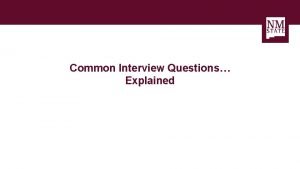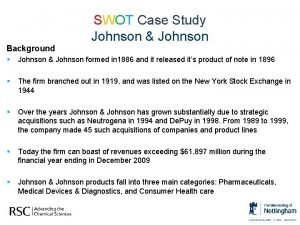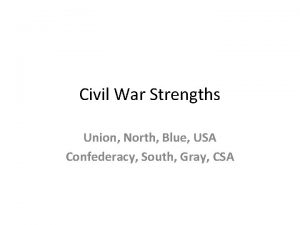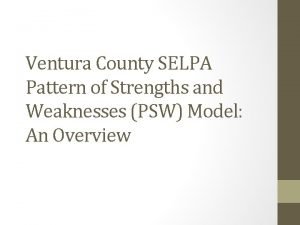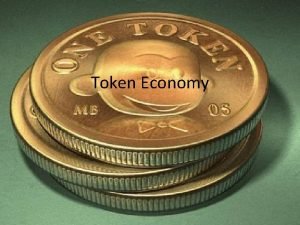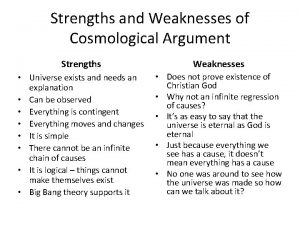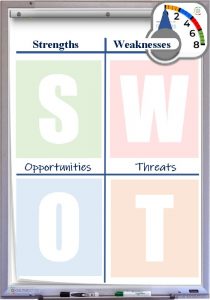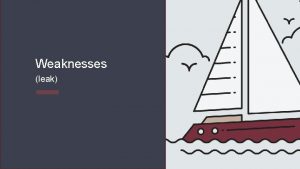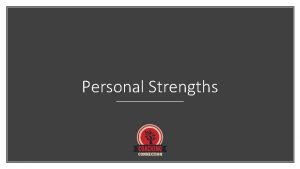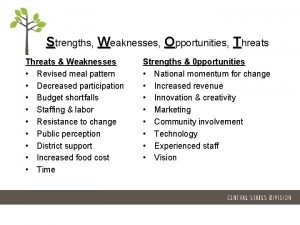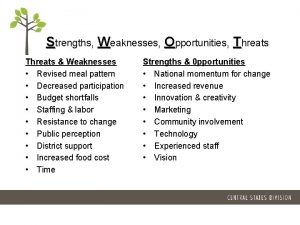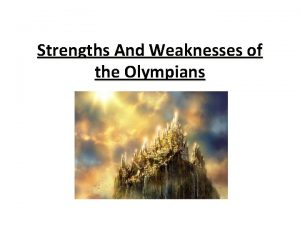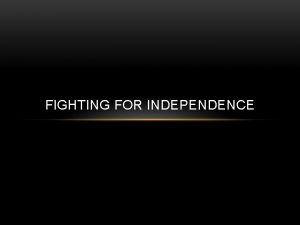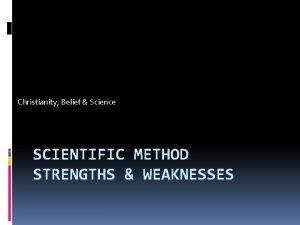Leadership Skills and Competencies Personal Strengths and Weaknesses











- Slides: 11

Leadership Skills and Competencies: Personal Strengths and Weaknesses Geoff Fairbanks Siena Heights University This Presentation was prepared for LDR 601 Taught by Professor Loughran

My Leadership Mission Statement To be an effective, motivating, energizing leader, who drives the business I am leading to the next level. � I develop and learn every day I am at work. I learn more from my people than anyone else. Over the years, their reactions and behaviors have taught me volumes of what it means to be an effective leader. Consequently, it has not been an easy road for me all the time. As you will see in this presentation, I have some strengths, but I highlight my weaknesses much more, as this is where my I feel I have the most room for growth as a leader.

Strengths www. dreamstime. com � � Trustworthy Leader ◦ I tend to be very open and honest with my teams. I pride myself in admitting mistakes when they are made, and never passing the buck. ◦ I try to always do what I say I am going to do, and follow up with that person when I reach an obstacle, or cannot accomplish the task. Trust is one of the most important things a leader must have with their teams to be effective! To me, establishing trust and having a for and not against—Cloud (2008) attitude foster a mutually beneficial, and productive environment, that fosters good will, and aligns teams towards a common good. Many of my activities with my teams revolve around engagement, transparency, goal setting, and recognizing accomplishments. I need trust to accomplish this effectively. www. clipartpanda. com

The fine line…. � Need balance on the leadership grid: ◦ According to Dubrin, sound management relies on trust and respect. The ideal state of the grid is a 9, 9 (High Concern for people, high concern for results. ) � What happens if we neglect concern for results? ◦ No concerns for results can create a “buddy” atmosphere. This phenomenon has been described as the Golem Effect—Babad, Inbar, and Rosenthal (1982. ) The Golem effect occurs in a setting where no expectations are made, or negative leader actions promote negative behavior in teams. It is a form of a self fulfilling prophecy. � The Pygmalion Effect—Rosenthal and Jacobsen (1968) ◦ Opposite of the Golem Effect. The theory surrounds the idea that high expectations will be returned with high performance in teams. High expectations without high concern for people will cause the Golem Effect to manifest itself.

Strengths (Cont. ) � Employee development and Leadership effectiveness: ◦ Received a score of 85% on leadership effectiveness survey from the plant floor employees. Company average is 68%, plant average is 48%. ◦ Recently had 14 new employees enter our production area. By using weekly meetings with each employee to identify goals, we identified specific action items to accomplish each week. It also was a platform for them to address issues they see and provide me with feedback. We were able to launch 2 new shifts of production with no loss of line throughput with all new people. ◦ I believe that these successes were a result of being very engaged with the employees, and constantly sharing feedback with them—good or bad. I think in the training situation it gave a sense of transparency, and made it easier to initially develop a task related relationship, as well as a personal relationship without tilting to far one way. I tend to employ both a participative, and consultative leadership style and people seem to respond well to it. In certain scenarios, it is required that I use an autocratic style of leadership. I typically feel like I have failed as a leader if I have to use this method frequently. A good friend of mine once told me “attitude reflects leadership. ” It boils down to our internal locus of control and confronting the facts that are actions are reflected in people. If people are behaving in an insubordinate manner, it is most likely from something you have done or created.

Vice Admiral James Stockdale � � � Vietnam POW for 7. 5 years Congressional medal of honor recipient The Stockdale Paradox—James Collins, Good to Great. (2001) ◦ “I never lost faith in the end of the story, I never doubted not only that I would get out, but also that I would prevail in the end and turn the experience into the defining event of my life, which, in retrospect, I would not trade. This is a very important lesson. You must never confuse faith that you will prevail in the end—which you can never afford to lose—with the discipline to confront the most brutal facts of your current reality, whatever that might be. ” http: //en. wikipedia. org/wiki/File: James_Stockdale_Formal_Portrait. jpg � Stockdale and the “Wake. ” We have to be brutally honest about the “wake” we create. Our internal locus of control is reflected in it, and the people we lead must swim in the wake. As leaders, we must be finely in tune with the wake we are creating, and retain the faith that we can change it.

The Brutal Facts--Weaknesses � � � Very high paced by nature ◦ Tend to miss details while operating on the fly ◦ Tend to ignore the brutal facts at times. Sometimes it takes time, and discipline to fully understand them and conquer them. I need to improve in this aspect ◦ Need to say No!! despite the best intentions: I Often commit to things, that I fully intend to do, but are not possible with the volume of other priorities and available resources Need to improve on having an “integrated character”—(Cloud 2008) ◦ Detachment from others perception is a weakness of mine ◦ Detachment from failures needs to be improved. “Let it go!” Need to improve on being assertive—especially with support groups. This also falls under integration of character, and the development of trust. Must have healthy debate to fully function as a team. . ◦ Not settling for mediocre effort and complacency ◦ Being more demanding in general of people performing at a high level. Earlier in my career, I was very demanding and it affected performance negatively. I need to find a better balance to my leadership grid, and not settle for what is comfortable. ◦ Need to continue to develop consistency in the way I treat those on my team.

Weakness Cont: Utilizing my nondominant personality Traits � Four Categories of Personality: http: //findingfaithhopeandlove. blogspot. com

Non Dominant personality Traits Cont: � � � I am classified as an Orange personality Type. People categorized as Gold, tend to have problems with my style. I am very driven, and often I seem overly impulsive to these people. I can be viewed as inconsiderate or punitive when that is not at all my intention. I am very flexible, and gold people think I am not rigid enough and that I have a tendency to play favorites. Over the years, I have learned to become much more green (data driven) and blue (caring, and compassionate. ) I can operate very effectively in these realms. It has been a struggle of mine to really reach out to the gold folks and be more structured in their eyes and be an effective leader to them. http: //equipyourlife. org/2014/06/05/why-you-need-structure-in-your-life /

Any Questions? � Thank you for listening! http: //blog. qwaya. com/finding-your-audience-on-facebook-infographic

References • Babad, E. Y. , Inbar, J, . Rosenthal, R. (1982). Journal of Educational Pyschology. • Cloud, H. (2008). Integrity, The Courage to Meet the Demands of Reality • Collins, James. (2001). Good to Great: Why Some Companies Make the Leap, and Others Don’t. • Dubrin, A. (2010). Leadership: Research, Findings, Practice, and Skills • Kierein, N. and Gold, M. (2000). Pygmalion in Work Organizations: A Meta-anaylsis. Journal of Organizational Behavior 21. 8. Dec 2000. 913 -928 • Lowry, D. (1979). True Colors Personality Test • Rosenthal R, . Jacobson, L, . (1964). Pygmalion in the Classroom: Teacher Expectations and Pupils Intellectual Development. Holt, Reinhart and Winston: New York
 Strength for interview for freshers
Strength for interview for freshers Johnson and johnson strengths and weaknesses
Johnson and johnson strengths and weaknesses Marks and spencer strengths and weaknesses
Marks and spencer strengths and weaknesses What were the british strengths and weaknesses
What were the british strengths and weaknesses Strengths of the confederacy
Strengths of the confederacy North and south strengths and weaknesses chart
North and south strengths and weaknesses chart Glanzer and cunitz strengths and weaknesses
Glanzer and cunitz strengths and weaknesses Mbti strengths and weaknesses
Mbti strengths and weaknesses Taba's model
Taba's model Ventura psw
Ventura psw Token economy in psychology
Token economy in psychology Characteristics of the articles of confederation
Characteristics of the articles of confederation
